Eclipse Environment
Our example use case simulates sales data coming from the field, and being processed via a Kinesis stream and written out into ElasticSearch where we can analyse the sales data graphically with Kibana. The sales data will be read from a CSV file, and have costs, quantities and transaction dates randomly applied. The architecture looks like this:
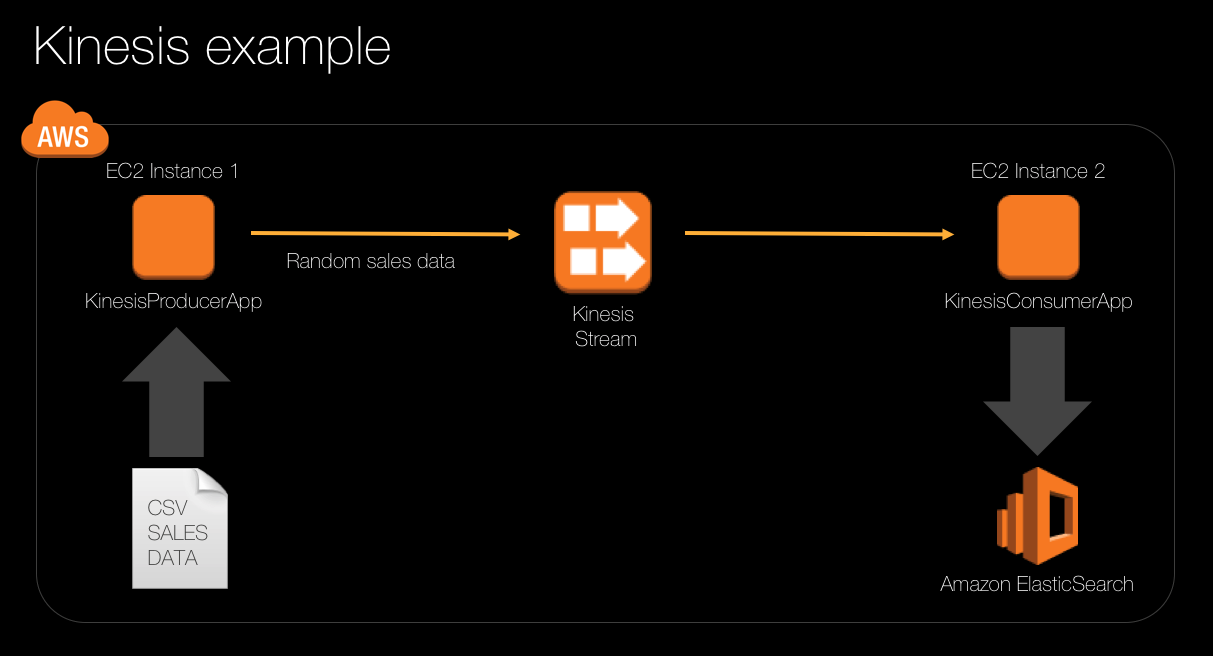
Contents
- Clone the repository in your development environment using the Eclipse IDE
- Clone the repository on the Kinesis Consumer EC2 instance
- Create a new repository for the Kinesis Producer source code
- Clone the repository in your development environment using the Eclipse IDE
- Open the AWS CodeCommit console in the browser.
- On the landing page, click Get Started
- On the Create repository page, for Repository name type
KinesisConsumer - For Description type
Sample application that consumes messages from a Kinesis stream and writes them to an ElasticSearch domain index.
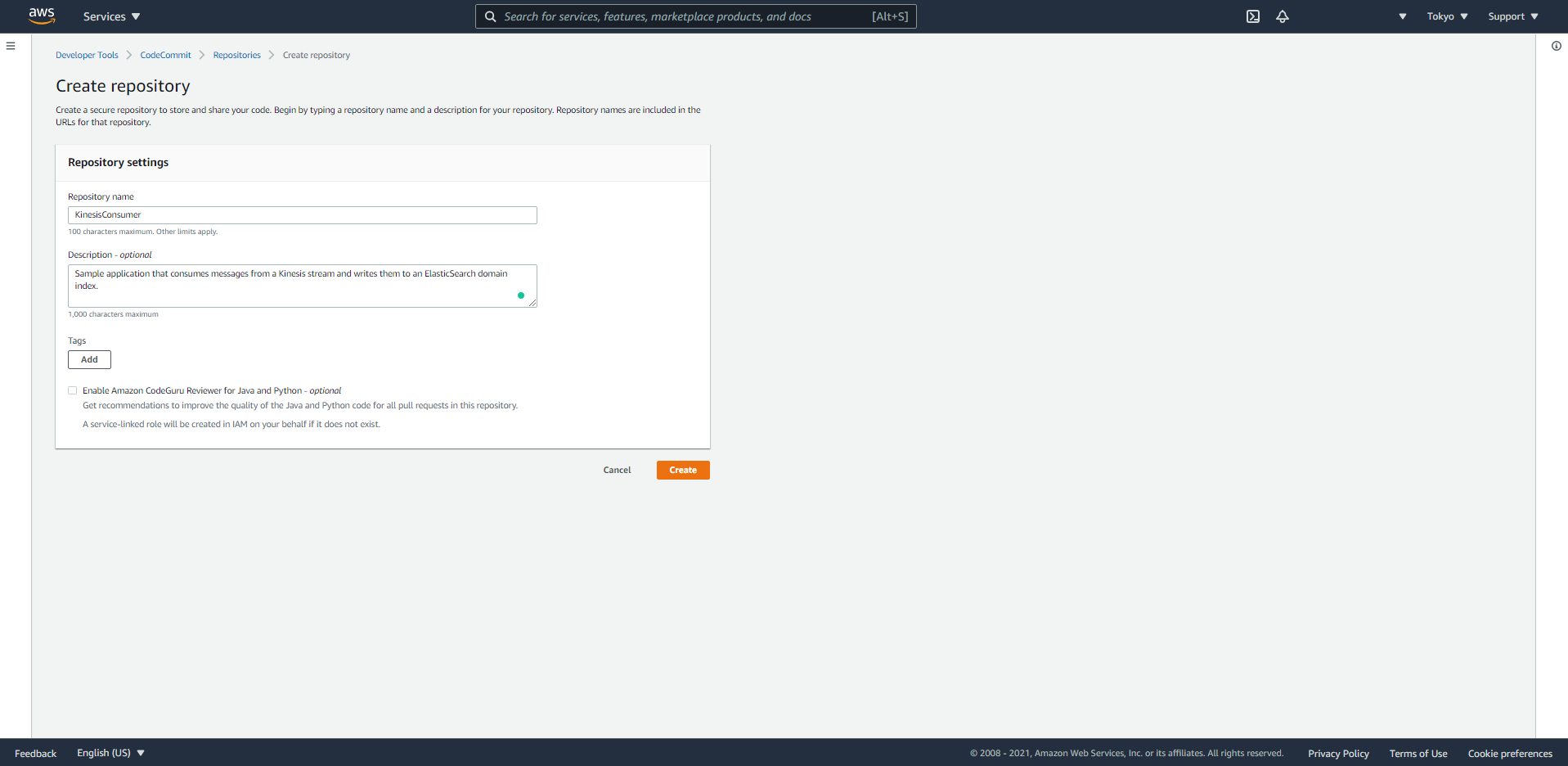
- Click Create repository. Your new repository will be created, ready for you to use. Click Skip to close the next screen. Click Close to close the panel that appears after the repository is created.
Clone the repository in your development environment using the Eclipse IDE
- In the Eclipse IDE, open the Git Perspective. If you don’t already have a shortcut to this perspective, use the Window | Perspective | Open Perspective | Git repositories menu option.
- Click the Clone repository icon (tooltip: Clone a repository and add the clone to this view)
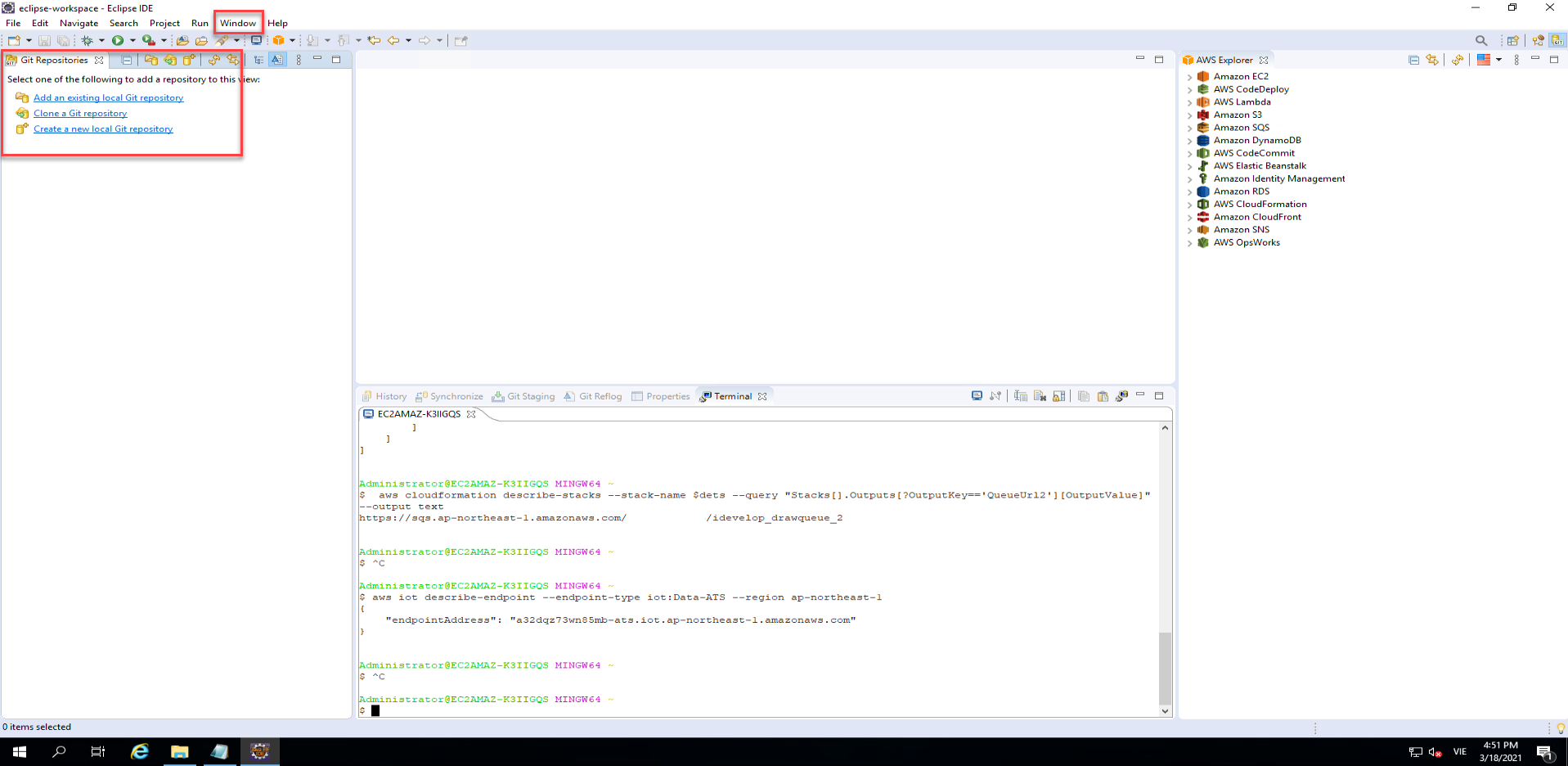
- In the AWS CodeCommit console in the browser, click the Clone URL button. Select HTTPS from the menu and then copy the URL into your clipboard.
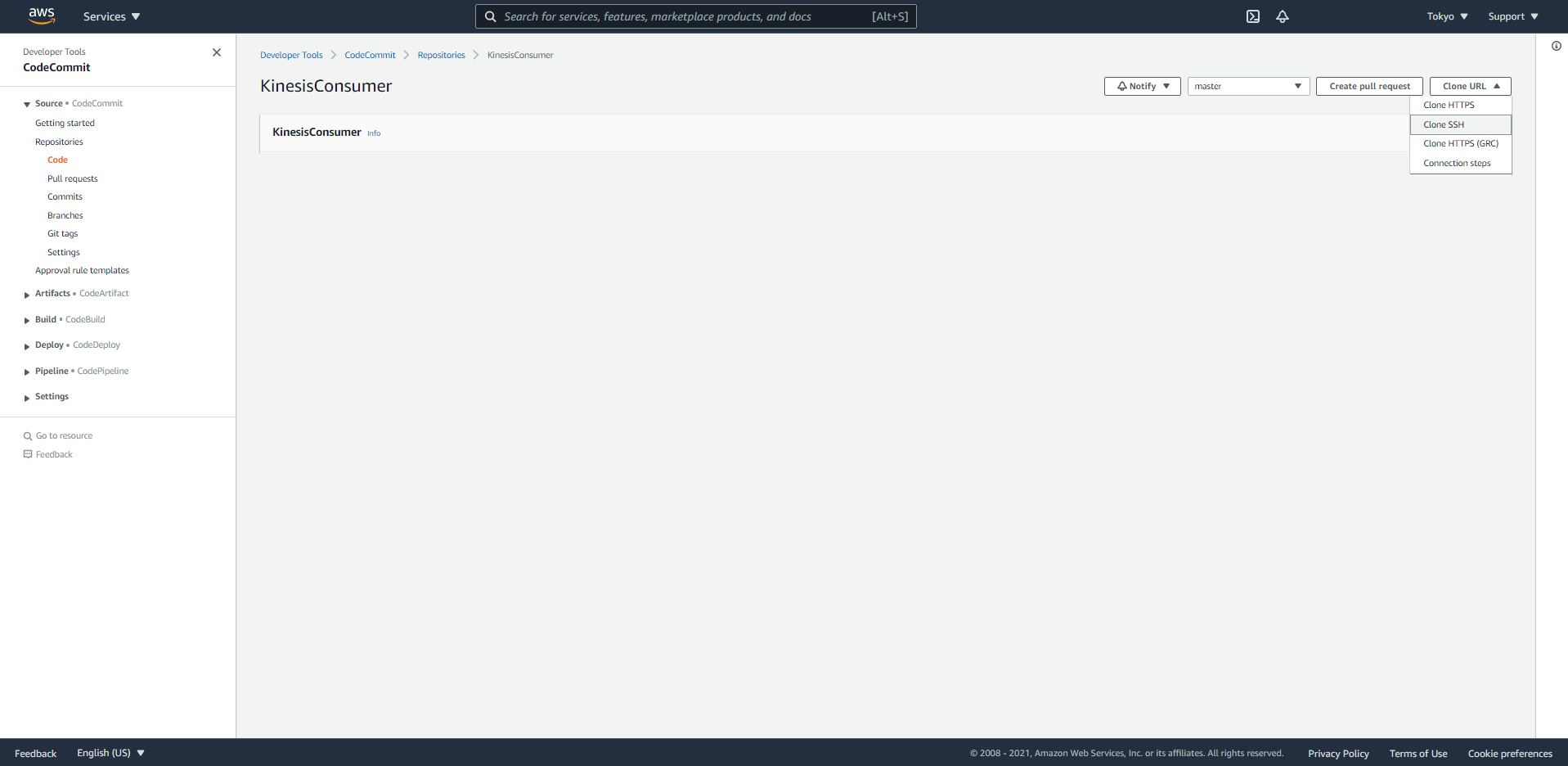
- Back in the Eclipse IDE, paste the clone URL into the URI field:
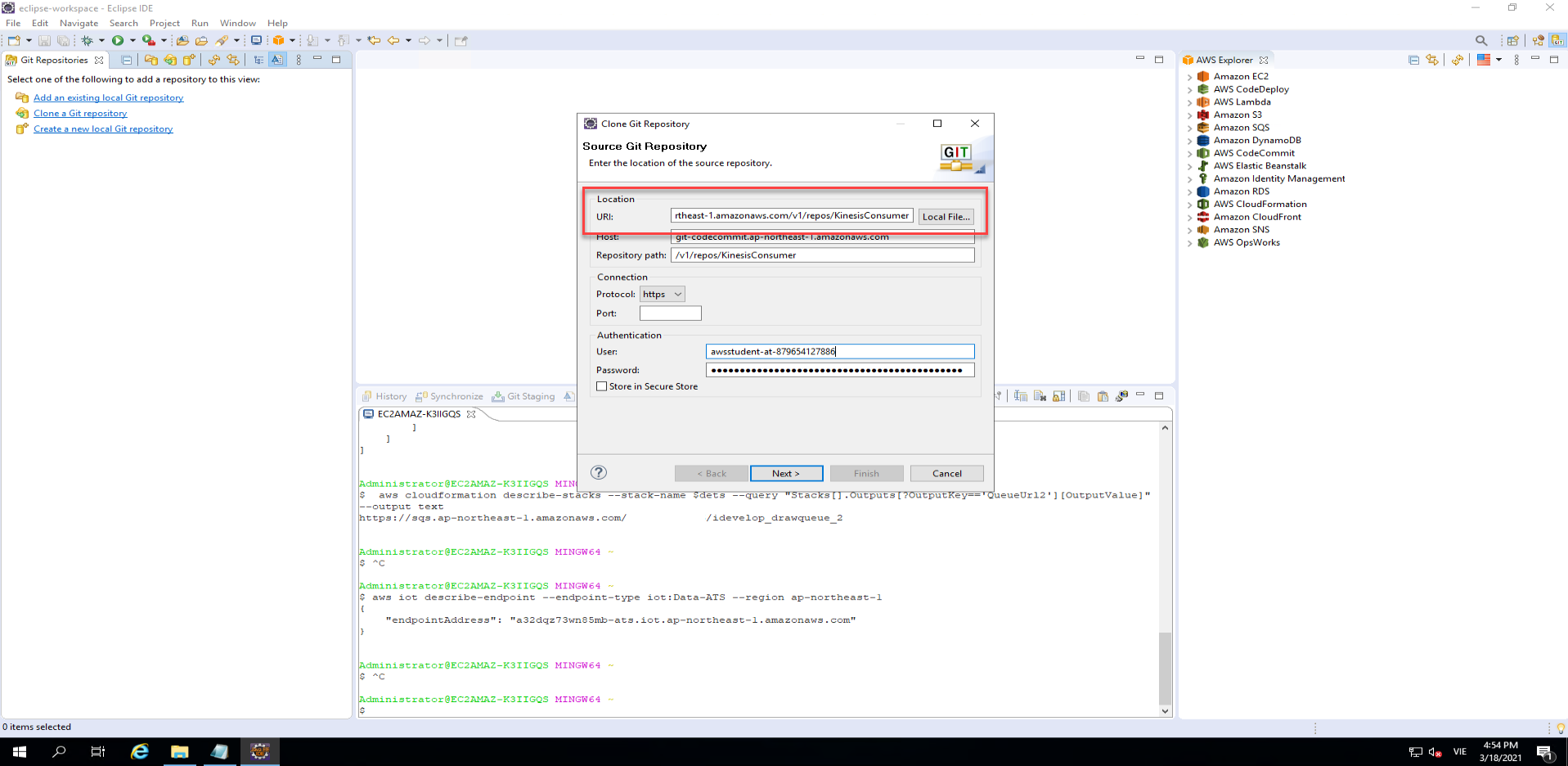
- In the Authentication section, for User paste in the GitUsername value from value from Cloudformation Output tab.
- For the Password field, paste in the GitPassword value from value from Cloudformation Output tab.
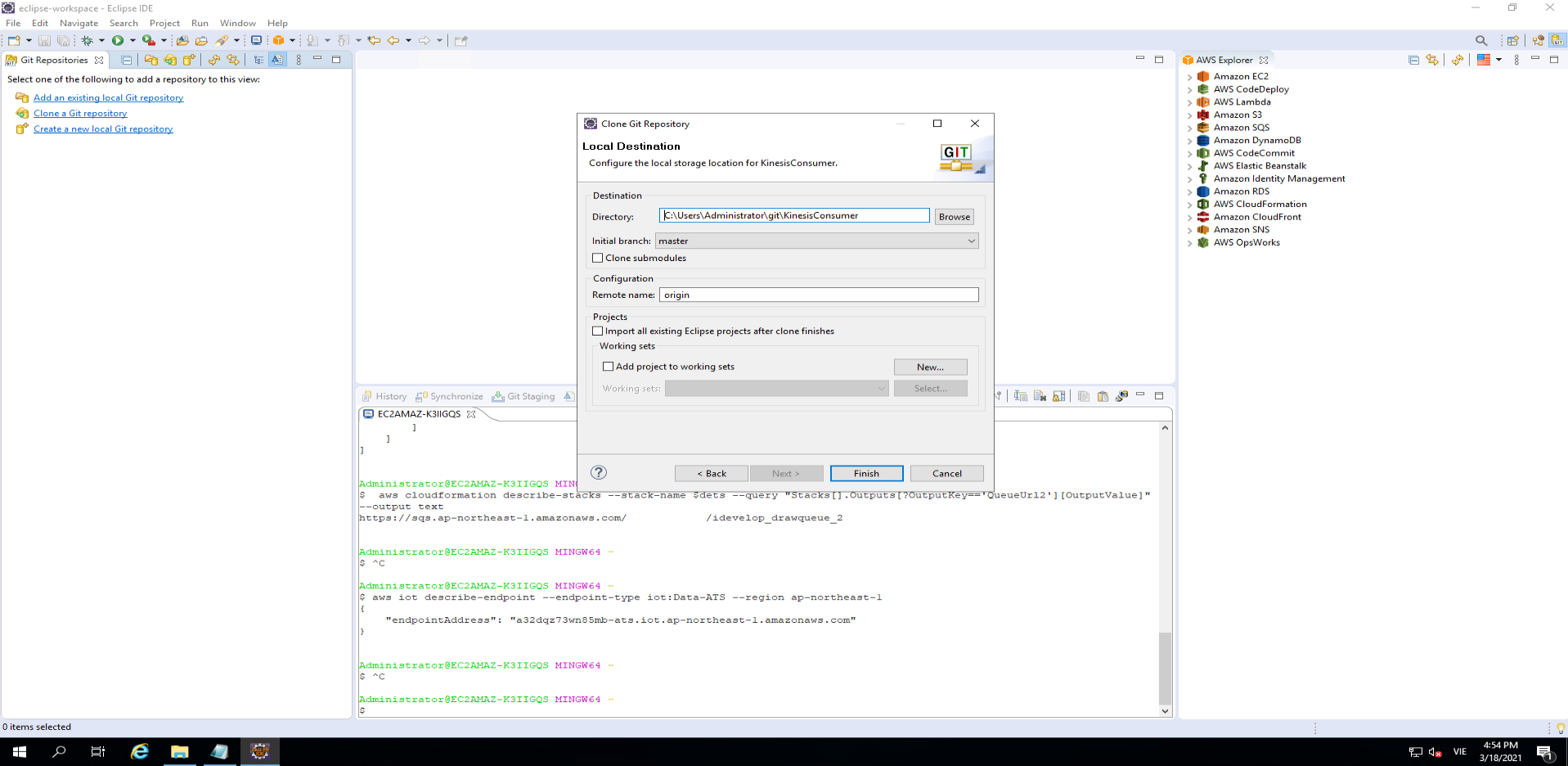
- Click Next
- In Branch Selection, there are no branches created, so just click Next.
- In the Local destination panel, select a suitable path on your development filesystem and click Finish:
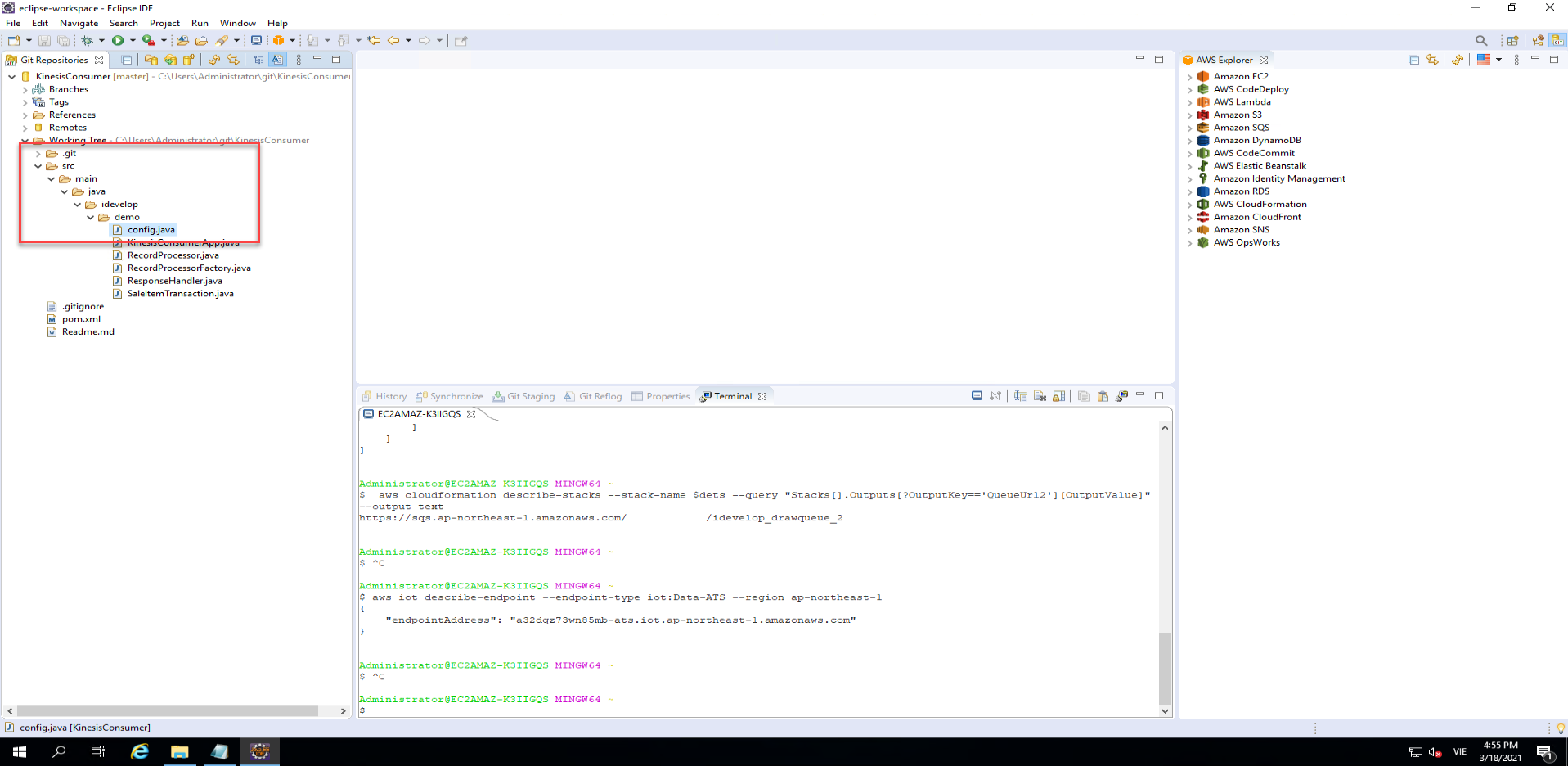
The empty repository will be cloned into the local filesystem path you specified.
- Download the source code bundle from KinesisConsumer.zip and explode the zip file onto your filesystem.
- Copy the contents of the exploded zip file across to the filesystem location where you have cloned the KinesisConsumer repository.
- In the Eclipse IDE, switch to the Java perspective and open the project from the filesystem by using the File | Open projects from filesystem… menu option.
- In the Eclipse IDE, open the config.java file.
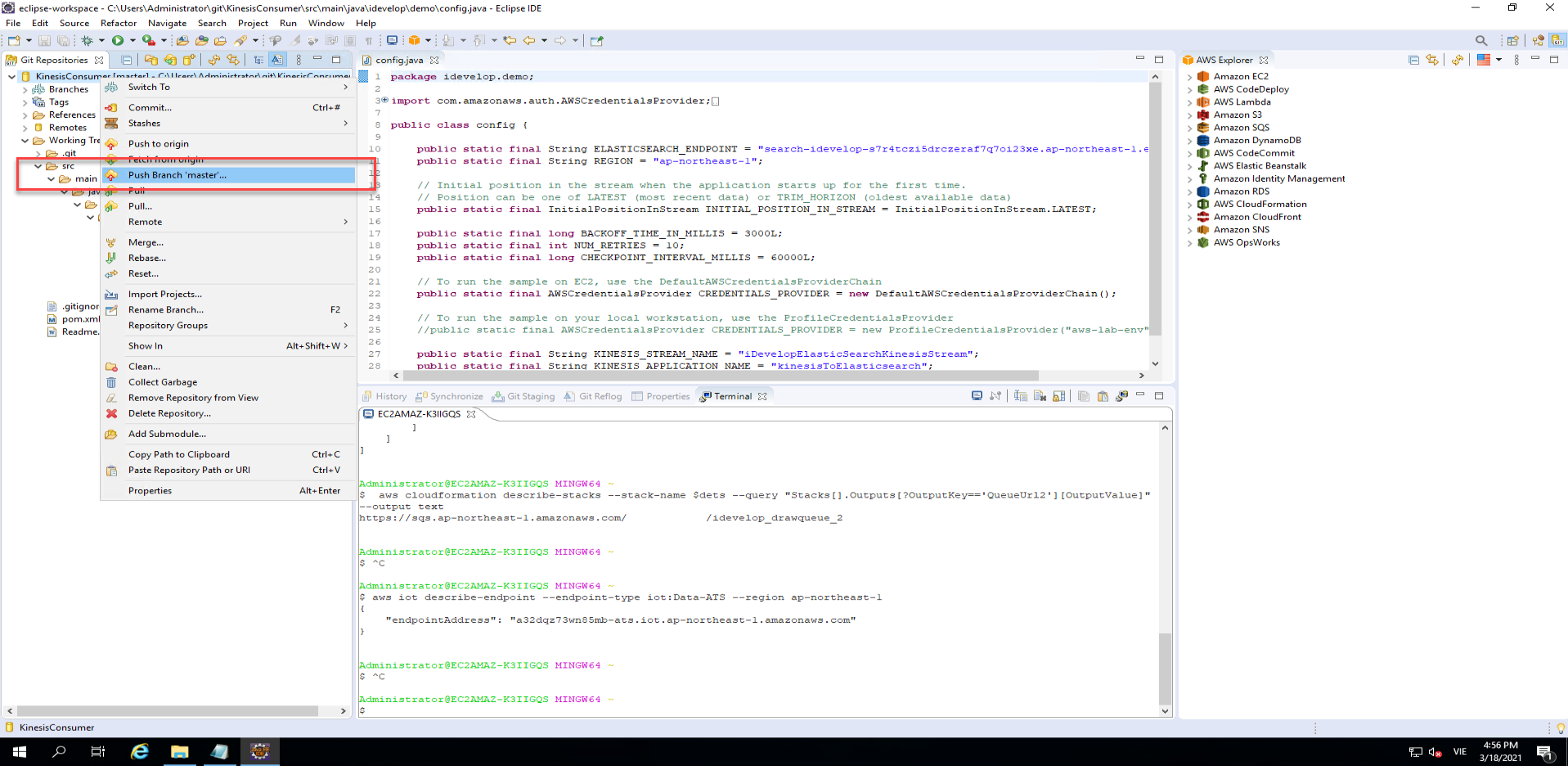
- Update the value of the
public static final String ELASTICSEARCH_ENDPOINTto match the value in value from Cloudformation Output tab, called ElasticsearchEndpoint. By default, the value is set to REPLACE_WITH_YOUR_ELASTIC_SEARCH_ENDPOINT. Erase this value and replace it with your ElasticsearchEndpoint value. Save the file. - Open a terminal window and
cdinto the folder where you cloned the repository. - Create a new master branch by issuing the command:
git checkout -b master
- Add the new files to the repository by issuing the command:
git add .
- Commit the new files to the branch by issuing the following command:
git commit -m "Initial commit"
- In the Eclipse IDE git perspective, right-click on the KinesisConsumer repository, and select Push Branch Master
If this option does not appear, or the branch Master is not present, you may need to use the refresh action to update the IDE.
- Click Finish. The branch will be pushed to the CodeCommit repository. Confirm this by refreshing the CodeCommit console in the web browser:
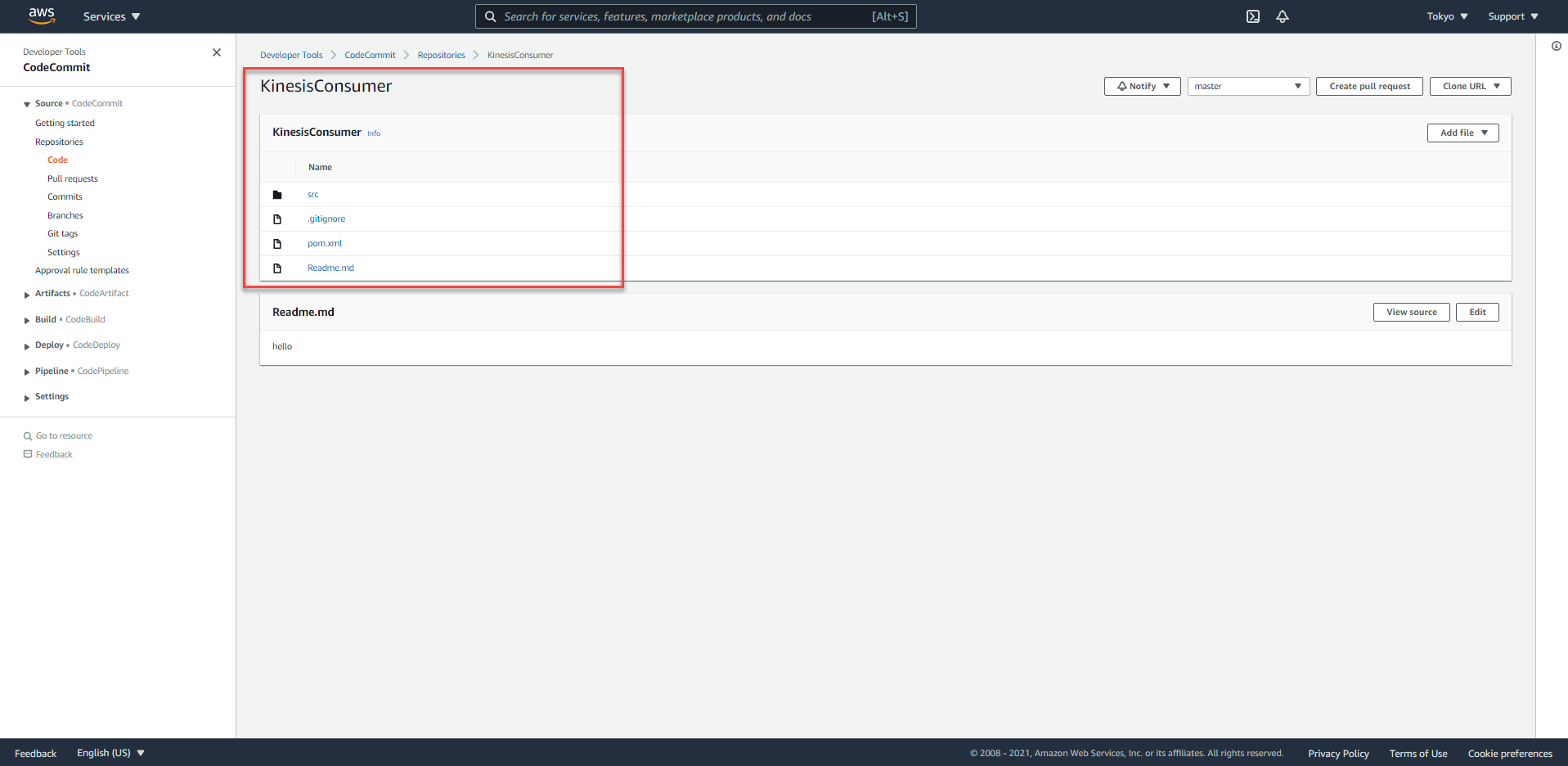
You should see the files that you have added into the repository listed in the browser view.
Clone the repository on the Kinesis Consumer EC2 instance
The labs setup has provisioned an EC2 instance for you to run as the Consumer in this scenario. You will now connect to the EC2 instance, clone the repository, build and run the Consumer code.
- In order to securely connect into your cloud infrastructure, you will use SSH, the secure shell. SSH requires a public/private key-pair to be set up and installed on the client and server that will communicate via the SSH protocol. The EC2 instances have been launched with a public key. You need to retrieve the private key so you can use that to establish a secure connection. Click Download PEM. Save this private key file on your local machine.
- In a terminal session on your local machine, run the following command. This command will ensure you can use the downloaded private key to log into the EC2 instances you will be using.
chmod 400 <path to your downloaded PEM file>
Example:
chmod 400 ~/Downloads/ee-default-keypair.pem
Leave the terminal session open, you will return shortly.
- Inside AWS Console, Cloudformation page, in the Outputs tab, locate the EC2InstanceKinesisConsumer value and copy it to your clipboard.
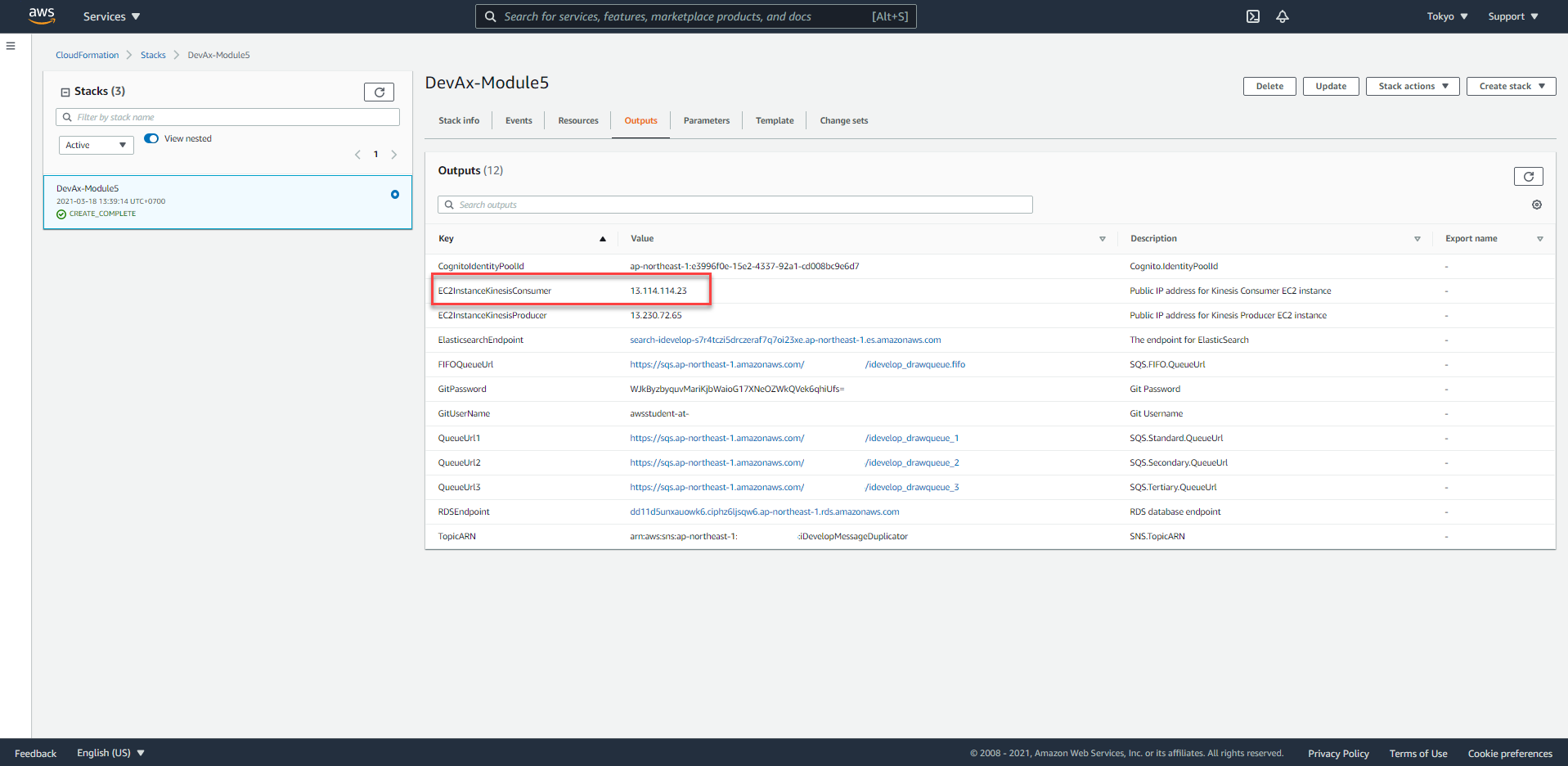
- Use the command below as a template to connect to the instance:
ssh -i <path to your downloaded PEM file> ec2-user@<EC2InstanceKinesisConsumer>
Example:
ssh -i ~/Downloads/ee-default-keypair.pem ec2-user@34.212.21.7
Don’t include the < and > symbols. If you have difficulty with this step please seek help from a lab assistant. Once you have successfully logged on to the instance via SSH, continue below.
- On the terminal window you used to SSH to the instance, issue this command to clone the repository:
git clone https://git-codecommit.ap-northeast-1.amazonaws.com/v1/repos/KinesisConsumer
You will be asked for username and password. You can obtain these from Cloudformation Outputs tab - look for GitUsername and GitPassword.
- The source code you had checked in from your workstation will now be cloned onto the EC2 instance and will take a moment to complete.
- The setup process has installed Maven on the EC2 instance so you can build the source code. cd into the KinesisConsumer directory and execute this command:
/opt/apache-maven-3.3.9/bin/mvn package shade:shade
It will take a few moments to complete the build.
- When the build is complete, start the Kinesis Consumer application by issuing:
java -jar target/KinesisConsumerApp-1.0.0.jar
The application will start and wait for events to be published into the Kinesis stream. You should see no errors, and after a few moments, the console output should show ‘Sleeping…’ since there are no records in the stream to process:
INFO: Initializing record processor for shard: shardId-000000000000
Aug 21, 2017 11:30:19 AM idevelop.demo.RecordProcessor initialize
INFO: Initializing record processor for shard: shardId-000000000001
Aug 21, 2017 11:30:57 AM com.amazonaws.services.kinesis.clientlibrary.lib.worker.Worker info
INFO: Current stream shard assignments: shardId-000000000001, shardId-000000000000
Aug 21, 2017 11:30:57 AM com.amazonaws.services.kinesis.clientlibrary.lib.worker.Worker info
INFO: Sleeping ...
Stop the execution in the terminal window by issuing CTRL + C
Create a new repository for the Kinesis Producer source code
You will now repeat the process above, this time, creating a repository for the Kinesis Producer application, and cloning it on to the Kinesis Producer EC2 instance. Once this is complete, you can begin testing data transfer between the two machines, via Amazon Kinesis.
The process of creating the repository is the same as the previous steps, but we repeat it here for convenience.
- Open the AWS CodeCommit console in the browser.
- On the Create repository page, for Repository name type
KinesisProducer - For Description type
Sample application that publishes sales events into a Kinesis stream. - Click Create repository. Your new repository will be created, ready for you to use. Click Skip in the next step. You can close the panel that appears after the repository is created.
Clone the repository in your development environment using the Eclipse IDE
-
In the Eclipse IDE, open the Git Perspective. If you don’t already have a shortcut to this perspective, use the Window | Perspective | Open Perspective menu option.
-
Click the Clone repository icon (tooltip: Clone a repository and add the clone to this view)
-
In the AWS CodeCommit console in the browser, click the Clone URL button. Copy the clone URL for HTTPS into your clipboard.
-
Back in the Eclipse IDE, paste the clone URL into the URI field.
-
The credentials you used in the previous steps should still be populated in the Authentication section - but if not, for User paste in the GitUsername value from Cloudformation Outputs tab. For the Password field, paste in the GitPassword value from Cloudformation Output tab.
-
Click Next
-
In Branch Selection, there are no branches created, so just click Next.
-
In the Local destination panel, select a suitable path on your development filesystem and click Finish:
The empty repository will be cloned into the local filesystem path you specified.
-
Download the source code bundle from KinesisProducer.zip and explode the zip file onto your filesystem.
-
Copy the contents of the exploded zip file across to the filesystem location where you have cloned the KinesisProducer repository.
-
Open a terminal window and
cdinto the folder where you cloned the repository. -
Create a new master branch by issuing the command:
git checkout -b master
- Add the new files to the repository by issuing the command:
git add .
- Commit the new files to the branch by issuing the following command:
git commit -m "Initial commit"
- In the Eclipse IDE git perspective, right-click on the KinesisProducer repository, and select Push Branch Master
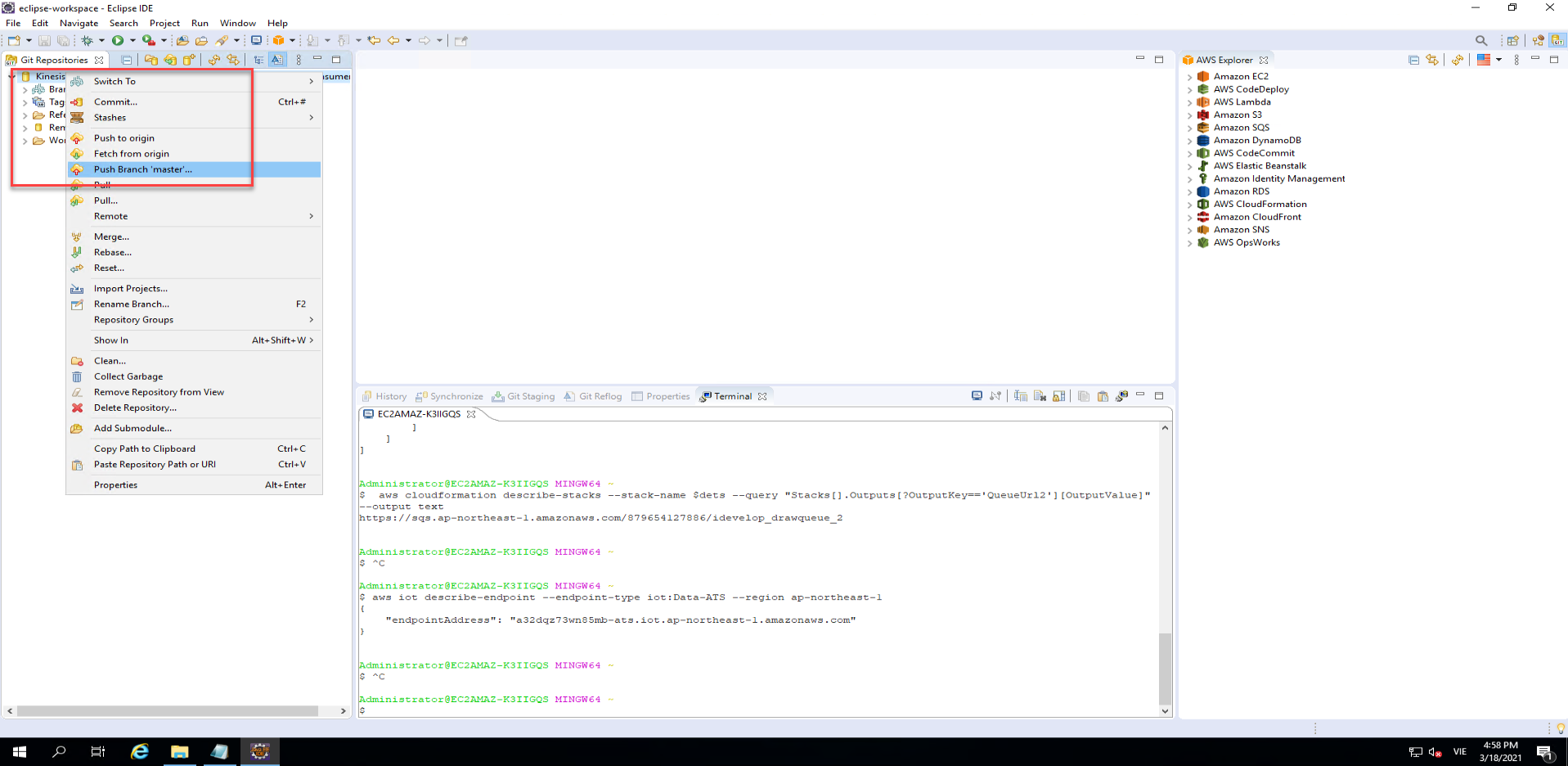
- Click Next and on the next page, click Finish.
The branch will be pushed to the CodeCommit repository. Confirm this by refreshing the CodeCommit console in the web browser. You should see the files that you have added into the repository listed in the browser view.